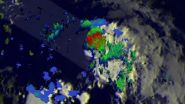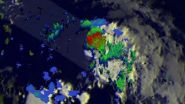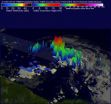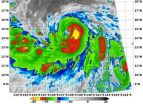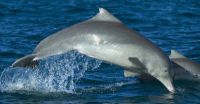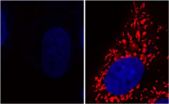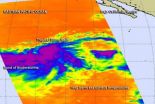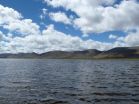(Press-News.org) VIDEO:
This 3-D flyby of Tropical Storm Bertha on Aug. 1 was created from TRMM satellite data. It shows (from the south) intense thunderstorms were reaching heights of over 15km (about...
Click here for more information.
The Tropical Rainfall Measuring Mission satellite known as TRMM found rain was falling heavily in the Atlantic Ocean's second tropical storm of the hurricane season. Bertha was close to the Lesser Antilles, prompting warnings and watches.
The National Hurricane Center (NHC) upgraded a well-defined low pressure center east-southeast of Barbados to Tropical Storm Bertha on July 31, 2014 at 0300 UTC (11 p.m. AST). Bertha's development is inhibited by upper-level shear that may weaken as the tropical storm moves over the northeastern Caribbean Sea.
Watches and Warnings in effect as of August 1 at 11 a.m. EDT (1500 UTC) include a Tropical Storm Warning for St. Lucia, Dominica, Martinique, Puerto Rico, Vieques, Culebra, the U.S. Virgin Islands and the British Virgin Islands. A Tropical Storm Watch is in effect for the eastern Dominican Republic from Cabo Frances Viejo to Isla Saona.
At 11 a.m. EDT (1500 UTC) the National Hurricane Center noted that the center of Tropical Storm Bertha was located near latitude 14.0 north and longitude 58.9 west, about 70 miles (110 km) southeast of Barbados. It was moving toward the west-northwest near 21 mph (33 kph) and that general motion is expected to continue for the next couple of days. NHC noted that Bertha is expected to move through the central Lesser Antilles during the night (August 1) and approach the Virgin Islands and Puerto Rico on Saturday, August 2. The estimated minimum central pressure is 1008 millibars.
The TRMM satellite, managed by both NASA and the Japan Aerospace Exploration Agency had an excellent view of tropical storm Bertha on August 1, 2014 at 0713 UTC (3:13 a.m. AST). Rainfall from TRMM's Microwave Imager (TMI) and Precipitation Radar (PR) revealed that rain was falling at a rate of over 109 mm (about 4.3 inches) per hour northeast of the sheared storm.
The National Hurricane Center noted Bertha is currently experiencing about 15-20 knots of southwesterly vertical wind shear which is pushing the heaviest rainfall northeast of the center. NHC also noted that water vapor imagery showed dry mid-/upper-level air near the storm. The forecast track calls for Bertha to interact with one or two upper-level troughs (elongated areas of low pressure) during the two to three days, which should cause some vertical wind shear and dry air to continue affecting the storm. Those are two factors that will limit the development and strengthening of the storm.
Radar reflectivity values from TRMM's Precipitation Radar (PR) instrument were used to create a 3-D view of the storm to show the structure of precipitation within Tropical Storm Bertha. The 3-D image showed that intense thunderstorms or "hot towers" were reaching heights of over 15km (about 9.3 miles). This kind of chimney cloud is called a "hot tower" because it releases a huge quantity of latent heat by condensation. The latent heat released in the center of tropical cyclones is usually an indicator of future intensification but vertical shear is expected to be a limiting factor for Bertha.
The NHC expects little change in Bertha's strength over the next two days.
INFORMATION:
Text credit: Harold F. Pierce
SSAI/NASA's Goddard Space Flight Center
NASA finds heavy rainfall and wind shear in newborn Tropical Storm Bertha
2014-08-01
ELSE PRESS RELEASES FROM THIS DATE:
Reptile Database surpasses 10,000 reptile species
2014-08-01
More than 10,000 reptile species have been recorded into the Reptile Database, a web-based catalogue of all living reptile species and classification, making the reptile species among the most diverse vertebrate groups in the world, alongside bird and fish species.
For some time, experts have projected that 2014 would mark the year that reptiles would become the most diverse vertebrate group in the world. Reptiles include snakes, lizards, turtles, crocodiles, tuataras and amphisbaenians.
"Officially, we have logged 10,038 reptile species into the database, which is ...
NASA sees Tropical Storm Halong's 'best side'
2014-08-01
NASA satellite data showed Tropical Storm Halong's "best side" or most powerful side was east of its center. That's where the coldest cloud top temperatures and strongest thunderstorms appeared on satellite imagery.
On August 1 at 13:30 UTC (9:30 a.m. EDT) the Moderate Resolution Imaging Spectroradiometer or MODIS instrument aboard NASA's Terra satellite captured an infrared picture of Tropical Storm Halong. The infrared data showed the coldest, strongest thunderstorm cloud-top temperatures east of the center of circulation. Cloud tops were as cold as -80F/-62C. Cloud ...
Advances in assisted reproduction create more options & new legal issues for LGBT couples
2014-08-01
New Rochelle, NY, August 1, 2014—Lesbian, gay, bisexual, and transgender individuals who want to conceive a child may face the same problems as some of their heterosexual and cisgendered peers, such as reduced fertility, but in addition they often face additional physiological and legal challenges to become parents. A comprehensive review of the most recent advances in assisted reproduction options is presented in the article "LGBT Assisted Reproduction: Current Practice and Future Possibilities," published in LGBT Health, a peer-reviewed journal from Mary Ann Liebert, ...
Scientists name new species of cetacean: The Australian humpback dolphin
2014-08-01
Scientists examining a taxonomically confused group of marine mammals have officially named a species new to science: the Australian humpback dolphin, Sousa sahulensis, according to the Wildlife Conservation Society and Clymene Enterprises.
The study describing the newly named species is the culmination of a 17-year long systematic examination of all available historical records, physical descriptions, and genetic data of humpback dolphins—a widespread group of coastal cetaceans ranging from the coast of West Africa to the northern coast of Australia. The Australian ...
Electronic reminders can help patients prevent surgical site infections
2014-08-01
CHICAGO (August 1, 2014)—The use of electronic reminders such as text messages, emails or voicemails is highly effective at getting surgical patients to adhere to a preadmission antiseptic showering regimen known to help reduce risk of surgical site infections (SSIs), according to a first-of-its-kind study published in the August issue of the Journal of the American College of Surgeons.
Each year approximately 400,000 SSIs occur and lead to a death rate approaching nearly 100,000 according to data sources cited by study authors. To help reduce the risk of these dangerous ...
Potential treatment and prevention of Parkinson's disease
2014-08-01
This news release is available in German.
Parkinson's disease affects neurons in the Substantia nigra brain region – their mitochondrial activity ceases and the cells die. Researchers at the Max Planck Institute of Molecular Cell Biology and Genetics show that supplying D-lactate or glycolate, two products of the gene DJ-1, can stop and even counteract this process: Adding the substances to cultured HeLa cells and to cells of the nematode C. elegans restored the activity of mitochondria and prevented the degeneration of neurons. They also showed that the two substances ...
NASA eyes powerful bands of thunderstorms in newborn Tropical Storm Iselle
2014-08-01
Tropical Storm Iselle was born in the Eastern Pacific Ocean soon after NASA's Aqua satellite gathered infrared imagery on the storm that showed powerful thunderstorms wrapping into developing storm's center. Iselle is not close enough to land to cause any watches or warnings.
The Atmospheric Infrared Sounder or AIRS instrument aboard NASA's Aqua satellite passed over System 95E on July 31 at 5:23 p.m. EDT from gathered infrared data before it became Tropical Storm Iselle. The data was made into a false-colored image at NASA's Jet Propulsion Laboratory in Pasadena, California. ...
Heavy metals and hydroelectricity
2014-08-01
Boulder, Colorado, USA – Hydraulic engineering is increasingly relied on for hydroelectricity generation. However, redirecting stream flow can yield unintended consequences. In the August 2014 issue of GSA Today, Donald Rodbell of Union College-Schenectady and coauthors from the U.S. and Peru document the wholesale contamination of the Lake Junín National Reserve by acid mine drainage from the Cerro de Pasco mining district.
According to the World Bank, about 60% of Peru's electricity is generated by hydropower, which during the dry season relies heavily on glacial meltwater ...
Scripps Research Institute scientists find new calorie-burning switch in brown fat
2014-08-01
LA JOLLA, CA—August 1, 2014—Biologists at The Scripps Research Institute (TSRI) have identified a signaling pathway that switches on a powerful calorie-burning process in brown fat cells.
The study, which is reported in this week's online Early Edition of the Proceedings of the National Academy of Sciences, sheds light on a process known as "brown fat thermogenesis," which is of great interest to medical researchers because it naturally stimulates weight loss and may also protect against diabetes.
"This finding offers new possibilities for the therapeutic activation ...
New mothers still excessively sleepy after 4 months: QUT study
2014-08-01
New mums are being urged to be cautious about returning to work too quickly, after a QUT study found one in two were still excessively sleepy four months after giving birth.
Dr Ashleigh Filtness, from QUT's Centre for Accident Research & Road Safety - Queensland (CARRS-Q), studied the sleep patterns and tiredness of postpartum mums and found despite new mums recording stable night sleep times at 18 weeks, they continued to report being excessively tired.
The CARRS-Q study, published in PLOS ONE, followed 33 healthy new mums who recorded their postpartum sleep patterns ...
